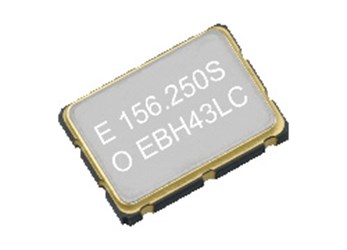Epson Introduces New Differential Output Crystal Oscillator

Achieves Low Phase Jitter of 65 fs Typ.*1
Seiko Epson Corporation, the world leader in quartz crystal technology, recently introduces availability of the SG7050EBN, a next-generation differential-output*2 crystal oscillator that achieves extremely low phase jitter*3.
Available over a frequency range of 100 MHz to 175 MHz, the SG7050EBN achieves 65 fs phase jitter. This performance is suitable for 10-, 40-, and 100-Gigabit Ethernet interconnect used in datacenters and central offices. The SG7050EBN will be used in wired networking equipment, both carrier and enterprise, such as high-end routers and switches.
The SG7050EBN achieves 65 fs phase jitter using an oscillator IC specifically designed for low noise and a high-frequency fundamental (HFF) AT-cut crystal*4 fabricated using Epson's proprietary QMEMS*5 process. Epson's HFF crystal technology is more reliable than legacy 3rd overtone crystals which are commonly used for these frequencies.
Epson also intends to address the diverse range of differential output formats used in networking equipment through the gradual release of new products supporting HCSL and LVDS standards. Committed to improving the design freedom of its customers, Epson's product lineup also features products in the highly compact 5032 (5.0 x 3.2 x 1.0 mm) package.
Moving forward, Epson will leverage its unique technological strengths in crystal microfabrication and semiconductors to provide customers with device solutions that are safe, easy to use, and dependable.
Terminology
*1:
Measured value at 156.25 MHz with offset frequency of 12 kHz - 20 MHz for LV-PECL differential output
*2 Differential output:
Differential signals are used for high-frequency clock and data signals to achieve good signal integrity and high noise immunity.
*3 Jitter:
Fluctuation among clock cycles, which can cause bit errors during data transfers.
*4 HFF (High-Frequency Fundamental) crystal:
An HFF crystal unit is a crystal chip that has been etched via a photolithographic process into the shape of an inverted mesa and oscillates at a high fundamental frequency.
*5 QMEMS:
QMEMS is a combination of "Quartz," a piezoelectric crystalline material that has excellent stability and precision, and "MEMS" micro electro-mechanical systems engineered using micro-fabrication technology. QMEMS devices combine the advantages of MEMS technology with the fundamental superiority of Quartz material.
About Epson
Epson is a global innovation leader whose product lineup ranges from inkjet printers and printing systems, 3LCD projectors and industrial robots to sensors and other microdevices. Dedicated to exceeding the vision of its customers worldwide, Epson delivers customer value based on compact, energy-saving, and high-precision technologies in markets spanning enterprise and the home to commerce and industry.
Led by the Japan-based Seiko Epson Corporation, the Epson Group comprises more than 73,000 employees in 94 companies around the world, and is proud of its ongoing contributions to the global environment and the communities in which it operates. For more information, visit http://global.epson.com/.
Source: Seiko Epson Corporation
